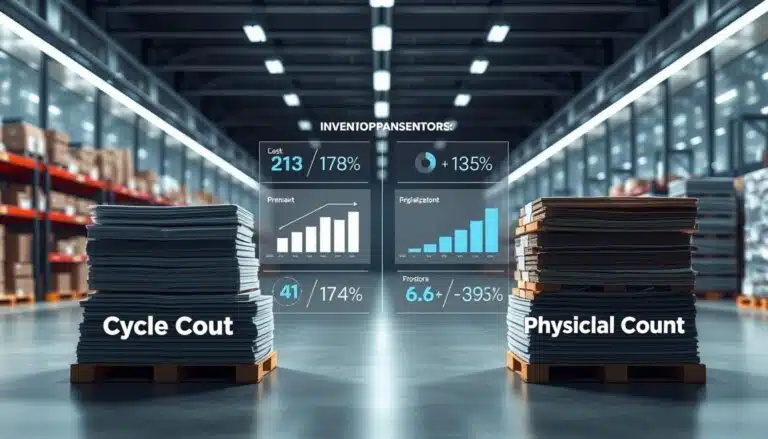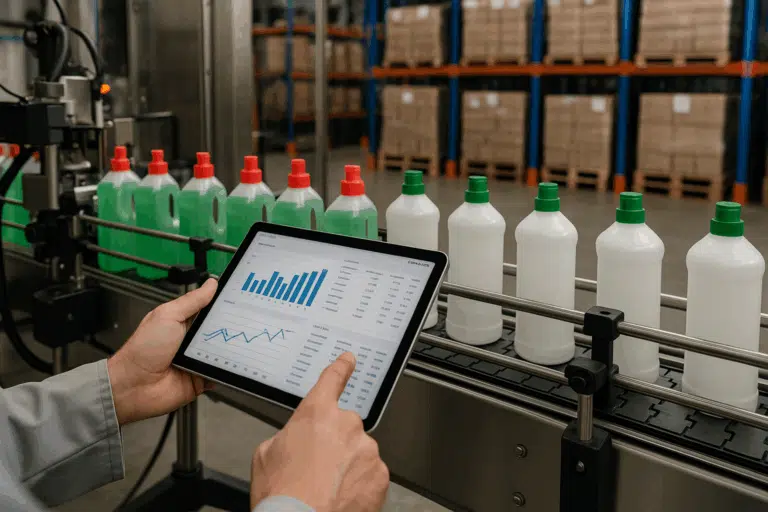In the world of inventory management, knowing the difference between Cycle Count and Physical Count is key. This knowledge helps businesses improve their efficiency. We will look at how these methods help control stock and improve logistics.
Accurate inventory management is vital. It helps cut costs, lowers errors, and makes logistics better. We’ll see how these counting methods play a big role in achieving these goals.
Table of Contents
ToggleIntroduction to Inventory Counting methods
Inventory management is crucial for any business wanting to succeed. It helps keep the right amount of stock. This ensures orders are filled on time and avoids problems with too much or too little stock.
Importance of Inventory Management
Good inventory management boosts a company’s profits and productivity. It helps businesses meet customer needs. Without it, companies might fall behind, losing out on chances and making unhappy customers.
Goals of Inventory Counting
Setting clear goals for inventory counting is key. These goals include being more accurate, efficient, and reducing errors. Meeting these goals improves productivity and supports effective inventory management.
Definition of Cycle Count
The Cycle Counting method is a systematic way to manage inventory. It involves counting a subset of items repeatedly over a set time. This approach is different from traditional counts, which stop all operations. It lets businesses stay efficient while keeping inventory accurate.
What is Cycle Counting?
Cycle Counting lets businesses check their inventory without stopping work. It helps find and fix errors fast, making inventory more accurate. Managers use it to control stock better, ensuring products are always ready for customers.
Steps involved in Cycle Count process
The Cycle Count Process has several important steps for inventory teams:
- Planning – Set a schedule and pick which items to count in each cycle.
- Selecting Items – Choose items based on sales or value.
- Conducting the Count – Count the chosen items to get accurate data.
- Reconciling Discrepancies – Check counted amounts against recorded levels to find differences.
- Updating Records – Update inventory records to show the correct stock levels.
Knowing these steps is key for inventory managers and logistics teams. A good cycle counting process leads to better inventory data and more efficient operations.
Definition of Physical Count
A Physical Inventory Count is when all items in stock are counted at once. This method stops operations to ensure everything is counted right. Knowing what a physical inventory count is helps understand its role in keeping stock records accurate.
What is a Physical Inventory Count?
A Physical Inventory Count is a detailed way to check stock levels. Businesses do this to make sure they have the right amount and condition of items. It helps find any differences between what’s recorded and what’s actually there, improving how they manage their stock.
How Physical Counts are conducted
The steps to conduct a physical count are key for good results. The process includes:
- Preparation: Getting the right data and organizing teams for counting.
- Counting: Counting each item by hand to make sure records are correct.
- Reconciliation: Checking counted items against inventory records to find any differences.
- Validation: Confirming the results and updating inventory systems.
When to use a Physical Count
It’s important to know when to do a Physical Count for good inventory management. It’s useful in situations like:
- Annual audits for a full stock check.
- First stock checks for new products or places.
- When big differences are found, needing a detailed check.
Using Physical Counts wisely can give important insights. It helps businesses keep their inventory accurate and make smart decisions.
Cycle Count vs. Physical Count: Key differences
How you count inventory can change how your business runs. Knowing the differences between Cycle and Physical Counts helps understand their effects on accuracy, reliability, and logistics. It’s key to see these differences to improve efficiency.
Frequency and timing of Counts
Cycle counting happens more often than physical counts. It’s done regularly to keep an eye on inventory. Physical counts, however, are less frequent, done yearly or every few years.
This difference affects how much it disrupts your business. Cycle Counts let you keep working without pause. Physical counts, though, can take a whole day or more, impacting productivity.
Accuracy and reliability of methods
The accuracy of your inventory methods is crucial. Cycle Counts, done often, spot issues early, making inventory more accurate. They help keep your inventory system reliable by checking it often.
Physical Counts, though thorough, might miss the mark if not done right. This can shake your confidence in your inventory data, which is vital for daily operations.
Impact on operations and logistics
The choice of inventory counting method affects logistics and decision-making. Cycle counting keeps inventory levels accurate, which is good for logistics. It helps avoid stockouts and overstock, key for a smooth supply chain.
Physical Counts, while detailed, can disrupt inventory management. This can lead to delayed decisions and resource use. Knowing these differences helps choose the best method for your business goals.
| Feature | Cycle Count | Physical Count |
|---|---|---|
| Frequency | Regular, ongoing | Periodic, typically annual |
| Disruption | Minimal | High |
| Inventory Accuracy | Ongoing improvements | Snapshot in time |
| Logistical Efficiency | Consistent | Variable |
Advantages and disadvantages of each method
Knowing the good and bad of cycle counting and physical inventory counts helps shape an organization’s inventory strategy. Each method has its own set of benefits and drawbacks. These factors are key in making a decision.
Pros of Cycle Counting
Cycle counting has many benefits. It keeps daily operations running smoothly, allowing staff to focus on their tasks while keeping inventory accurate. It also means inventory levels and any issues can be tracked and fixed quickly.
Cons of Cycle Counting
However, cycle counting has its downsides. It needs dedicated staff to work well. Without proper management, it can lead to mistakes in inventory records. These issues can make the inventory management system less reliable.
Pros of Physical Inventory Counts
Physical inventory counts give a detailed look at all inventory, improving accuracy. They are great for finding any inventory discrepancies. This method provides a solid foundation for inventory validation, helping to understand stock levels and conditions better.
Cons of Physical Inventory Counts
But, physical inventory counts can disrupt regular business activities. They require a lot of time and resources, which can cause delays in customer orders or other tasks. This might make managers hesitant to do them often, especially in busy environments.
| Method | Pros | Cons |
|---|---|---|
| Cycle Counting |
|
|
| Physical Inventory Counts |
|
|
Conclusion
Both Cycle Count and Physical Count are key in managing inventory well. Cycle counting checks inventory often, keeping operations smooth. Physical counts, however, give a detailed look at inventory levels, especially for big checks or audits.
Each method has its good points and downsides. Cycle counting keeps inventory accurate but needs regular effort and team involvement. Physical counts are detailed but use a lot of resources. It’s important to think about your business’s specific needs and budget when choosing a method.
Consider the advice given in this article when deciding on an inventory counting method. If you want to improve your inventory management or find ways to save money, talking to experts could help. They can help you use your resources better.
FAQ
What is the difference between cycle counting and physical inventory counts?
Cycle counting is done regularly, focusing on a small part of the inventory. It doesn’t stop operations. On the other hand, a physical count involves checking all items at once. This often means stopping work for a while. These methods change how inventory is managed and affect logistics.
How often should a cycle count be conducted?
Cycle counts can happen as often as weekly or daily, depending on how fast items sell. Many choose to count monthly. But, some prefer more frequent counts to keep inventory records accurate.
When is it appropriate to perform a physical inventory count?
You should do a physical count during annual audits or when inventory records don’t match. It’s also good to count items when you move or change inventory systems.
What are the benefits of cycle counting?
Cycle counting keeps operations running smoothly. It updates inventory records often and finds errors quickly. This is great for businesses that need to keep inventory moving without losing track.
What are the drawbacks of physical inventory counts?
Physical counts can slow down work, take a lot of time, and upset customers. These issues can hurt logistics and how well you manage inventory.
How does accuracy in counting methods impact overall inventory management?
Being accurate in counting is key for inventory management. It affects how much stock you have, how you fulfill orders, and your financial reports. Accurate counts help avoid wasting money on too much stock or not enough. This makes customers happier and helps logistics run better.
Can both cycle counting and physical inventory counts be used together?
Yes, many use both methods. Cycle counts help keep an eye on inventory daily. Physical counts are used to check if cycle counts are right and to set a solid inventory baseline.





























